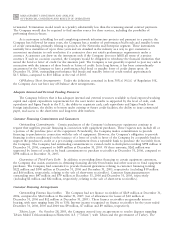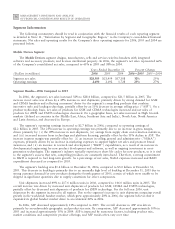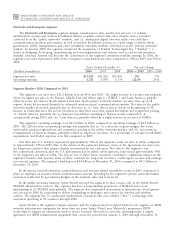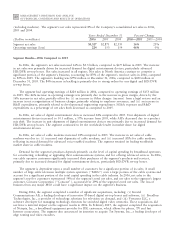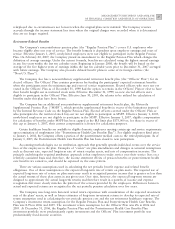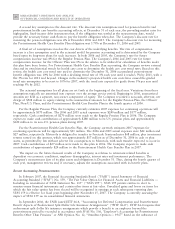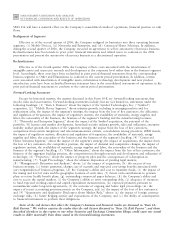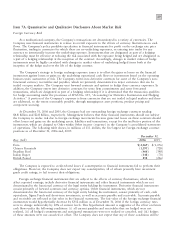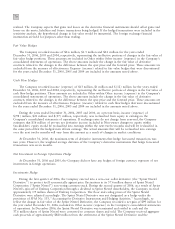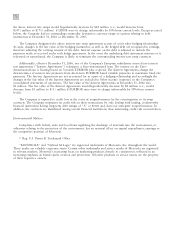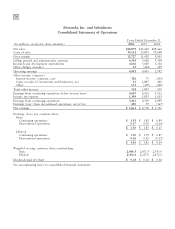Motorola 2006 Annual Report Download - page 72
Download and view the complete annual report
Please find page 72 of the 2006 Motorola annual report below. You can navigate through the pages in the report by either clicking on the pages listed below, or by using the keyword search tool below to find specific information within the annual report.
64 MANAGEMENT'S DISCUSSION AND ANALYSIS
OF FINANCIAL CONDITION AND RESULTS OF OPERATIONS
Valuation of Investments and Long-Lived Assets
The Company assesses the impairment of investments and long-lived assets, which includes identifiable
intangible assets, goodwill and property, plant and equipment, whenever events or changes in circumstances indicate
that the carrying value may not be recoverable. Factors considered important that could trigger an impairment
review include: (i) underperformance relative to expected historical or projected future operating results,
(ii) changes in the manner of use of the assets or the strategy for our overall business, (iii) negative industry or
economic trends, (iv) declines in stock price of an investment for a sustained period, and (v) our market
capitalization relative to net book value.
When the Company determines that the carrying value of intangible assets, goodwill and long-lived assets may
not be recoverable, an impairment charge is recorded. Impairment is generally measured based on a projected
discounted cash flow method using a discount rate determined by our management to be commensurate with the
risk inherent in our current business model or prevailing market rates of investment securities, if available.
At December 31, 2006 and 2005, the net book values of these assets were as follows (in millions):
December 31
2006
2005
Property, plant and equipment $2,267 $2,020
Investments 895 1,644
Intangible assets 354 231
Goodwill 1,706 1,349
$5,222 $5,244
The Company recorded fixed asset impairment charges of $15 million in both 2006 and 2005, compared to no
charges in 2004.
The Company recorded impairment charges related to its investment portfolio of $27 million, $25 million and
$36 million in 2006, 2005 and 2004, respectively, representing other-than-temporary declines in the value of the
Company's investment portfolio, primarily related to cost-based investment write-downs. Additionally, the available-
for-sale securities portfolio reflected a net pre-tax unrealized gain position of $60 million and $157 million at
December 31, 2006 and 2005, respectively.
The Company performs a goodwill impairment test at the reporting unit level at least annually on
October 1, or more often should triggering events occur. In determining the fair value of the reporting unit, the
Company utilizes independent appraisal firms who employ a combination of present value techniques and quoted
market prices of comparable businesses. No impairment charges were required in 2006 or 2005. During 2004, the
Company determined that goodwill related to a sensor business, which was subsequently divested in 2005, was
impaired by $125 million.
The Company cannot predict the occurrence of future impairment-triggering events nor the impact such events
might have on these reported asset values. Such events may include strategic decisions made in response to the
economic conditions relative to product lines or operations and the impact of the economic environment on our
customer base.
Restructuring Activities
The Company maintains a formal Involuntary Severance Plan (the ""Severance Plan'') which permits the
Company to offer eligible employees severance benefits based on years of service and employment grade level in
the event that employment is involuntarily terminated as a result of a reduction-in-force or restructuring. Each
separate reduction-in-force has qualified for severance benefits under the Severance Plan and, therefore, such
benefits are accounted for in accordance with SFAS No. 112, ""Accounting for Postemployment Benefits''
(""SFAS 112''). Under the provisions of SFAS 112, the Company recognizes termination benefits based on formulas
per the Severance Plan at the point in time that future settlement is probable and can be reasonably estimated
based on estimates prepared at the time a restructuring plan is approved by management. Exit costs primarily
consist of future minimum lease payments on vacated facilities. At each reporting date, the Company evaluates its
accruals for exit costs and employee separation costs to ensure the accruals are still appropriate. In certain
circumstances, accruals are no longer required because of efficiencies in carrying out the plans or because
employees previously identified for separation resigned from the Company and did not receive severance or were


